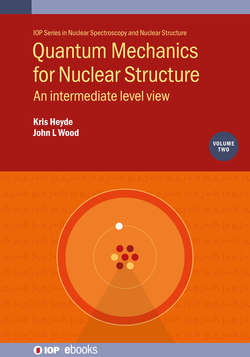Читать книгу Quantum Mechanics for Nuclear Structure, Volume 2 - Professor Kris Heyde - Страница 5
На сайте Литреса книга снята с продажи.
Contents
ОглавлениеPreface
Author biographies
1 Representation of rotations, angular momentum and spin
1.1 Rotations in (3, R)
1.2 Matrix representations of spin and angular momentum operators
1.3 The Pauli spin matrices
1.4 Matrix representations of rotations in ket space
1.5 Tensor representations for SU(2)
1.6 Tensor representations for SO(3)
1.7 The Schwinger representations for SU(2)
1.8 A spinor function basis for SU(2)
1.9 A spherical harmonic basis for SO(3)
1.10 Spherical harmonics and wave functions
1.11 Spherical harmonics and rotation matrices
1.12 Properties of the rotation matrices
1.13 The rotation of 〈jm∣
1.14 The rotation of the Ylm(θ,ϕ)
1.15 Exercises
1.16 Spin-12 particles; neutron interferometry
1.17 The Bargmann representation
1.17.1 Representation of operators
1.18 Coherent states for SU(2)
1.19 Properties of SU(2) from coherent states
1.20 Exercises
References
2 Addition of angular momenta and spins
2.1 The coupling of two spin-12 particles
2.2 The general coupling of two particles with spin or angular momentum
2.3 Spin–orbit coupling
2.4 Vector spherical harmonics
2.5 Clebsch–Gordan coefficients and rotation matrices
2.6 The coupling of many spins and angular momenta and their recoupling
2.6.1 6-j coefficients
2.6.2 9-j coefficients
3 Vector and tensor operators
3.1 Vector operators
3.2 Tensor operators
3.3 Matrix elements of spherical tensor operators and the Wigner–Eckart theorem
4 Identical particles
4.1 Slater determinants
4.2 The occupation number representation for bosons
4.3 The occupation number representation for fermions
4.4 Hamiltonians and other operators in the occupation number representation
4.4.1 Exercises
4.5 Condensed states (superconductors and superfluids)
4.5.1 Two fermions in a degenerate set of levels with a pairing force
4.5.2 Many fermions in a degenerate set of levels with a pairing force: the quasispin formalism
4.5.3 BCS theory
4.6 The Lipkin model
Reference
5 Group theory and quantum mechanics
5.1 Definition of a group
5.2 Groups and transformation
5.2.1 Translations
5.2.2 Rotations
5.2.3 Space–time transformation
5.3 Transformation on physical systems
5.4 Quantum mechanics: a synoptic view
5.5 Symmetry transformations in quantum mechanics
5.5.1 The unitary transformations for translations, rotations, and time evolution in quantum mechanics
5.5.2 Consequences of symmetry in quantum mechanics
5.6 Models with symmetry in quantum mechanics
5.7 Groups and algebras
5.8 Dynamical or spectrum generating algebras
5.9 Matrix groups
5.9.1 Discrete matrix groups
5.9.2 Continuous matrix groups
5.9.3 Compact and non-compact groups
5.9.4 Polynomial representation of groups
5.10 Generators of continuous groups and Lie algebras
5.10.1 The matrix group SO(3) and its generators
5.10.2 Unitary groups and SU(2)
5.11 The unitary and orthogonal groups in n dimensions, U(n) and SO(n)
5.12 Casimir invariants and commuting operators
5.12.1 The Casimir invariants of u(n)
5.12.2 The Casimir invariants of so(n)
6 Algebraic structure of quantum mechanics
6.1 Angular momentum theory as an application of a Lie algebra
6.2 The Lie algebra su(1,1) ∼ sp(1,R)
6.3 Rank-2 Lie algebras
6.3.1 su(3) and the isotropic harmonic oscillator in three dimensions
6.3.2 so(4) and the hydrogen atom (Kepler problem)
6.4 so(5) and models with ‘quadrupole’ degrees of freedom (Bohr model)
6.5 The Lie algebra sp(3,R) and microscopic models of nuclear collectivity
6.6 Young tableaux
6.6.1 SU(3) tensor tableau calculus
6.6.2 Multiplicity of a weight state in an SU(3) irrep
6.6.3 Dimension of an SU(3) irrep: Robinson ‘hook-length’ method (figure 6.8)
6.6.4 SU(2) irreps contained in an SU(3) irrep
6.6.5 Kronecker products
6.7 Introduction to Cartan theory of Lie algebras
6.7.1 Cartan structure of the so(4) Lie algebra
6.7.2 Cartan structure of the su(3) Lie algebra
6.7.3 The generic Lie algebra
6.7.4 Irrep quantum numbers: Cartan subalgebras and Casimir operators
Reference
7 Perturbation theory and the variational method
7.1 Time-independent perturbation theory
7.1.1 Exercises
7.2 Time-independent perturbation theory for systems with degeneracy
7.3 An example of (second-order) degenerate perturbation theory
7.4 Perturbation theory and symmetry
7.4.1 Example
7.4.2 Inversion symmetry
7.4.3 Example
7.4.4 Exercises
7.5 The variational method
8 Time-dependent perturbation theory
8.1 The interaction picture
8.2 Time-dependent perturbation theory
8.3 Constant perturbations and Fermi’s golden rule
Reference
9 Electromagnetic fields in quantum mechanics
9.1 The quantization of the electromagnetic field
9.2 The interaction of the electromagnetic field with matter
9.3 The emission and absorption of photons by atoms
References
10 Epilogue
Reference
Appendices
Appendix A
Appendix B
